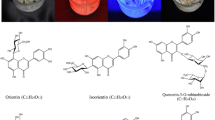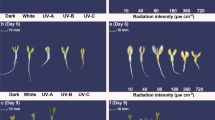Abstract
It is known that flavonoids in sprouts were accumulated more under light irradiation than under dark. Light source affecting flavonoid accumulation in sprouts is still investigating. We evaluated the effects of light sources, including red, blue and fluorescent lights, on the flavonoid accumulation and antioxidant activity in common buckwheat sprouts. Experimental results showed that blue light significantly enhanced the contents of C-glycosylflavones, including orientin, vitexin and their isomers, and rutin and a rutin isomer. Sprouts grown under blue light exhibit also the highest total phenolics and total flavonoids as well as the highest antioxidant activities. It was found that isoorientin is the highest antioxidant flavonoid whereas numerous former studies suggested that rutin is a typical antioxidant compound in common buckwheat. These results indicated that blue light could be applied for enhancing not only the content of flavonoids but also antioxidant activity in common buckwheat sprouts.




Similar content being viewed by others
References
Reth M. Hydrogen peroxide as second messenger in lymphocyte activation. Nat. Immunol. 3: 1129–1134 (2002)
Block G, Patterson B, Subar A. Fruit, vegetables, and cancer prevention: a review of the epidemiological evidence. Nutr. Cancer 18: 1–29 (1992)
Kim S-L, Kim S-K, Park C-H. Introduction and nutritional evaluation of buckwheat sprouts as a new vegetable. Food Res. Int. 37: 319–327 (2004)
Kim S-J, Zaidul ISM, Suzuki T, Mukasa Y, Hashimoto N, Takigawa S, Noda T, Matsuura-Endo C, Yamauchi H. Comparison of phenolic compositions between common and tartary buckwheat (Fagopyrum) sprouts. Food Chem. 110: 814–820 (2008)
Gulpinar AR, Orhan IE, Kan A, Senol FS, Celik SA, Kartal M. Estimation of in vitro neuroprotective properties and quantification of rutin and fatty acids in buckwheat (Fagopyrum esculentum Moench) cultivated in Turkey. Food Res. Int. 46: 536–543 (2012)
Ishii S, Katsumura T, Shiozuka C, Ooyauchi K, Kawasaki K, Takigawa S, Fukushima T, Tokuji Y, Kinoshita M, Ohnishi M. Anti-inflammatory effect of buckwheat sprouts in lipopolysaccharide-activated human colon cancer cells and mice. Biosci. Biotechnol. Biochem. 72: 3148–3157 (2008)
Xiao J, Capanoglu E, Jassbi AR, Miron A. Advance on the flavonoid C-glycosides and health benefits. Crit. Rev. Food Sci. Nutr. 56: S29–S45 (2016)
Tsurunaga Y, Takahashi T, Katsube T, Kudo A, Kuramitsu O, Ishiwata M, Matsumoto S. Effects of UV-B irradiation on the levels of anthocyanin, rutin and radical scavenging activity of buckwheat sprouts. Food Chem. 141: 552–556 (2013)
Schuerger AC, Brown CS, Stryjewski EC. Anatomical features of pepper plants (Capsicum annuum L.) grown under red light-emitting diodes supplemented with blue or far-red light. Ann. Bot. 79: 273–282 (1997)
Wu M-C, Hou C-Y, Jiang C-M, Wang Y-T, Wang C-Y, Chen H-H, Chang H-M. A novel approach of LED light radiation improves the antioxidant activity of pea seedlings. Food Chem. 101: 1753–1758 (2007)
Qian H, Liu T, Deng M, Miao H, Cai C, Shen W, Wang Q. Effects of light quality on main health-promoting compounds and antioxidant capacity of Chinese kale sprouts. Food Chem. 196: 1232–1238 (2016)
Lee S-W, Seo JM, Lee M-K, Chun J-H, Antonisamy P, Arasu MV, Suzuki T, Al-Dhabi NA, Kim S-J. Influence of different LED lamps on the production of phenolic compounds in common and Tartary buckwheat sprouts. Ind. Crops Prod. 54: 320–326 (2014)
Thwe AA, Kim YB, Li X, Seo JM, Kim S-J, Suzuki T, Chung S-O, Park SU. Effects of light-emitting diodes on expression of phenylpropanoid biosynthetic genes and accumulation of phenylpropanoids in Fagopyrum tataricum sprouts. J. Agr. Food Chem. 62: 4839–4845 (2014)
Seo J-M, Arasu MV, Kim Y-B, Park SU, Kim S-J. Phenylalanine and LED lights enhance phenolic compound production in Tartary buckwheat sprouts. Food Chem. 177: 204–213 (2015)
Nam TG, Lee SM, Park J-H, Kim D-O, Baek N-i, Eom SH. Flavonoid analysis of buckwheat sprouts. Food Chem. 170: 97–101 (2015)
Singleton VL, Rossi JA, Jr. Colorimetry of total phenolics with phosphomolybdic-phosphotungstic acid reagents. Am. J. Enol. Vitic. 16: 144–158 (1965)
Zhishen J, Mengcheng T, Jianming W. The determination of flavonoid contents in mulberry and their scavenging effects on superoxide radicals. Food Chem. 64: 555–559 (1999)
Tang D, Dong Y, Guo N, Li L, Ren H. Metabolomic analysis of the polyphenols in germinating mung beans (Vigna radiata) seeds and sprouts. J. Sci. Food. Agric. 94: 1639–1647 (2014)
Liu H, Chen Y, Hu T, Zhang S, Zhang Y, Zhao T, Yu H, Kang Y. The influence of light-emitting diodes on the phenolic compounds and antioxidant activities in pea sprouts. J. Funct. Foods 25: 459–465 (2016)
Lim YJ, Eom SH. Effects of different light types on root formation of Ocimum basilicum L. cuttings. Sci. Hort. 164: 552–555 (2013)
Shiga T, Shoji K, Shimada H, Hashida S-n, Goto F, Yoshihara T. Effect of light quality on rosmarinic acid content and antioxidant activity of sweet basil, Ocimum basilicum L. Plant Biotechnol. 26: 255–259 (2009)
Takemiya A, Inoue S, Doi M, Kinoshita T, Shimazaki K. Phototropins promote plant growth in response to blue light in low light environments. Plant Cell. 17: 1120–1127 (2005)
Wade HK, Bibikova TN, Valentine WJ, Jenkins GI. Interactions within a network of phytochrome, cryptochrome and UV‐B phototransduction pathways regulate chalcone synthase gene expression in Arabidopsis leaf tissue. Plant J. 25: 675–685 (2001)
Wang H, Jiang YP, Yu HJ, Xia XJ, Shi K, Zhou YH, Yu JQ. Light quality affects incidence of powdery mildew, expression of defence-related genes and associated metabolism in cucumber plants. Eur. J. Plant Pathol. 127: 125–135 (2010)
Taulavuori K, Hyöky V, Oksanen J, Taulavuori E, Julkunen-Tiitto R. Species-specific differences in synthesis of flavonoids and phenolic acids under increasing periods of enhanced blue light. Environ. Exp. Bot. 121: 145–150 (2016)
Wang J, Wang Y, Chen B, Kawabata S, Li Y. Comparative transcriptome analysis revealed distinct gene set expression associated with anthocyanin biosynthesis in response to short-wavelength light in turnip. Acta Physiol. Plant. 38: 1–12 (2016)
Hollman PC, van Trijp JM, Buysman MN, Mengelers MJ, de Vries JH, Katan MB. Relative bioavailability of the antioxidant flavonoid quercetin from various foods in man. FEBS Lett. 418: 152–156 (1997)
Li H-B, Wong C-C, Cheng K-W, Chen F. Antioxidant properties in vitro and total phenolic contents in methanol extracts from medicinal plants. LWT-Food Sci. Technol. 41: 385–390 (2008)
Huang D, Ou B, Prior RL. The chemistry behind antioxidant capacity assays. J. Agr. Food Chem. 53: 1841–1856 (2005)
Kim D-O, Lee KW, Lee HJ, Lee CY. Vitamin C equivalent antioxidant capacity (VCEAC) of phenolic phytochemicals. J. Agr. Food Chem. 50: 3713–3717 (2002)
Heim KE, Tagliaferro AR, Bobilya DJ. Flavonoid antioxidants: chemistry, metabolism and structure-activity relationships. J. Nutr. Biochem. 13: 572–584 (2002)
Mora A, Paya M, Rios J, Alcaraz M. Structure-activity relationships of polymethoxyflavones and other flavonoids as inhibitors of non-enzymic lipid peroxidation. Biochem. Pharmacol. 40: 793–797 (1990)
Acknowledgements
This study was supported by a grant from the Individual Basic Science and Engineering Research Program, National Research Foundation of Korea, Republic of Korea (Grant No. NRF-2014R1A1A2058838).
Author information
Authors and Affiliations
Corresponding author
Ethics declarations
Conflict of interest
The authors declare no conflict of interest.
Rights and permissions
About this article
Cite this article
Nam, T.G., Kim, DO. & Eom, S.H. Effects of light sources on major flavonoids and antioxidant activity in common buckwheat sprouts. Food Sci Biotechnol 27, 169–176 (2018). https://doi.org/10.1007/s10068-017-0204-1
Received:
Revised:
Accepted:
Published:
Issue Date:
DOI: https://doi.org/10.1007/s10068-017-0204-1




